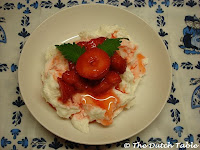 |
| Boterkoek has a distinct pattern pressed into the dough with the tines of a fork |
The Dutch Buttercake consists of hardly anything else than butter, sugar and flour. Just for giggles, lemon zest, salt and vanilla is added, but the main ingredients are those three key players in the Dutch baking world. Buttercake is just like it sounds: a dense, buttery, sweet cake that sticks to your ribs. And there's nothing wrong with that!
Do make sure all the butter is incorporated into the dough, or it will leave small airpockets in the cake as the butter melts. It's not going to make it taste any different, but it just looks better.
Boterkoek is usually baked for fifteen minutes, but it's one of the trickier cakes to gauge when it's done. As soon as the top starts to color and the sides are slightly dry, it will be ready: you want the inside to still be fairly soft but baked. If you bake it too long, the taste will still be good but the cake will be dry and dense. Nothing wrong with that, and everybody likes their boterkoek a certain way, so you will just have to give it a try and see. Fifteen minutes usually does the trick, but if the middle is still wet, bake it a little longer. After you pull the cake, it's cooled and cut into small squares or narrow slices. It really doesn't lend itself too well for large pieces: it is a heavy cake that is best eaten in small amounts. It can be baked in its original form, or filled with amandelspijs (divide the dough in half, press one half in the pan, spread the almond paste, then cover with the second half of the dough).
Boterkoek
2 sticks of cold butter
2 cups of flour
3/4 cup of sugar
1/8th teaspoon salt
2 eggs
1 vanilla bean
Lemon zest from one lemon
Mix the flour with the sugar, the salt, one egg, the seeds of the vanilla bean and the lemon zest. Cut in the cold butter, then knead the dough until it all comes together. If the dough gets too sticky, wrap it in plastic film and refrigerate it briefly.
Butter a 9 inch pie form, pat the dough into the pan and make sure the top is even. Make markings with a fork as in the first picture, beat the second egg and brush the top of the cake with it, then bake in a 350F oven for about 15 - 20 minutes. Keep an eye on it, and as soon as the sides begin to pull away and toast, it's ready.
Let the cake totally cool before cutting it into narrow slices or squares.










